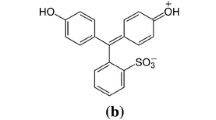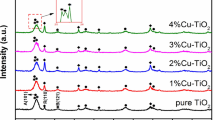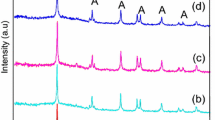Abstract
Redox abilities of rutile TiO2 powder with an acicular primary particle, having about a 200 m2/g BET surface area obtained by a homogeneous precipitation process in aqueous TiOCl2 solution at 50°C for 4 hrs, were investigated using a photocatalytic reaction in aqueous 4-chlorophenol, Cu- and Pb-EDTA solutions. Its abilities were then compared with those of commercial P-25 powder, together with investigating those of anatase TiO2 powder obtained from the aqueous TiOCl2 solution, having a similar surface area and primary particle shape as those of the rutile powder. The powder was more effective than the anatase or P-25 powder, while the anatase powder unexpectedly showed the slowest decomposition rate and the smallest amount in the same experiments in spite of similar particle shapes and surface area. From the results, it is found that the excellent photo redox abilities of the powder is likely to be caused by the specific powder preparation method regardless of crystalline structures even when having similar particle shapes and values in the surface area. Also, many OH− attached to the surface of the TiO2 particle appeared to interfere with the adsorption of decomposing target materials to the TiO2 surface in the solution during the photocatalytic reaction, resulting in a delay in the reaction.
Similar content being viewed by others
References
I. Ilisz, Z. Laszlo and A. Dombi,Appl. Catal. A 180, 25 (1999).
X. Li, J. W. Cubbage, T. A. Tetzlaff and W. S. Jenks,J. Org. Chem. 64, 8509 (1999).
J. Chen, D. F. Ollis, W. H. Rulkens and H. Bruning,Colloids & Surf. A 151, 393 (1999).
Z. Zhang, C. C. Wang, Z. Zakaria and J. Y. Ying,J. Phys. Chem. B 102, 10871 (1998).
C. C. Wang, Z. Zhang and J. Y. Ying,Nanostruct. Mater. 9, 583 (1997).
G. A. Somorjai,Chemistry in Two Dimensions: Surface, p. 551, Cornel University Press, Ithaca, U.S.A. (1981).
S. J. Kim, S. D. Park, C. K. Rhee, W. W. Kim and S. Park,Scripta mater. 44, 1229 (2001).
R. R. Bacsa and J. Kiwi,Appl. Catal. B 16, 19 (1998).
D. S. Seo, J. K. Lee and H. Kim,J. Kor. Ceram. Soc. 37, 700 (2000).
H. A. Ekabi, N. Serpone, E. Pelizzetti, C. Minero, M. A. Fox and R. B. Draper,Langmuir 5, 20 (1989).
Author information
Authors and Affiliations
Rights and permissions
About this article
Cite this article
Song, J.S., Lee, D.Y., Lee, W.J. et al. Redox abilities of rutile TiO2 ultrafine powder in aqueous solutions. Met. Mater. Int. 8, 103–109 (2002). https://doi.org/10.1007/BF03027036
Issue Date:
DOI: https://doi.org/10.1007/BF03027036




